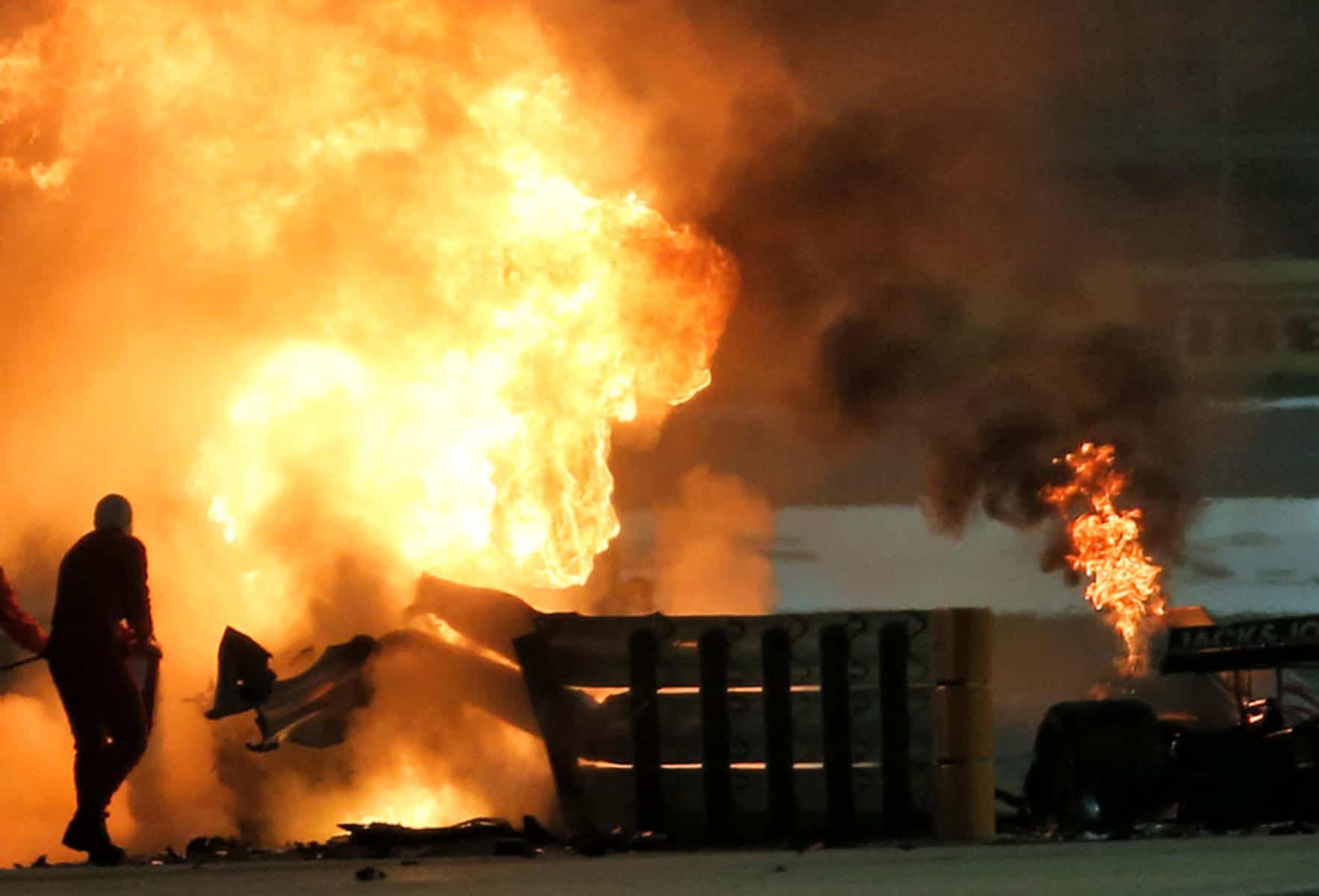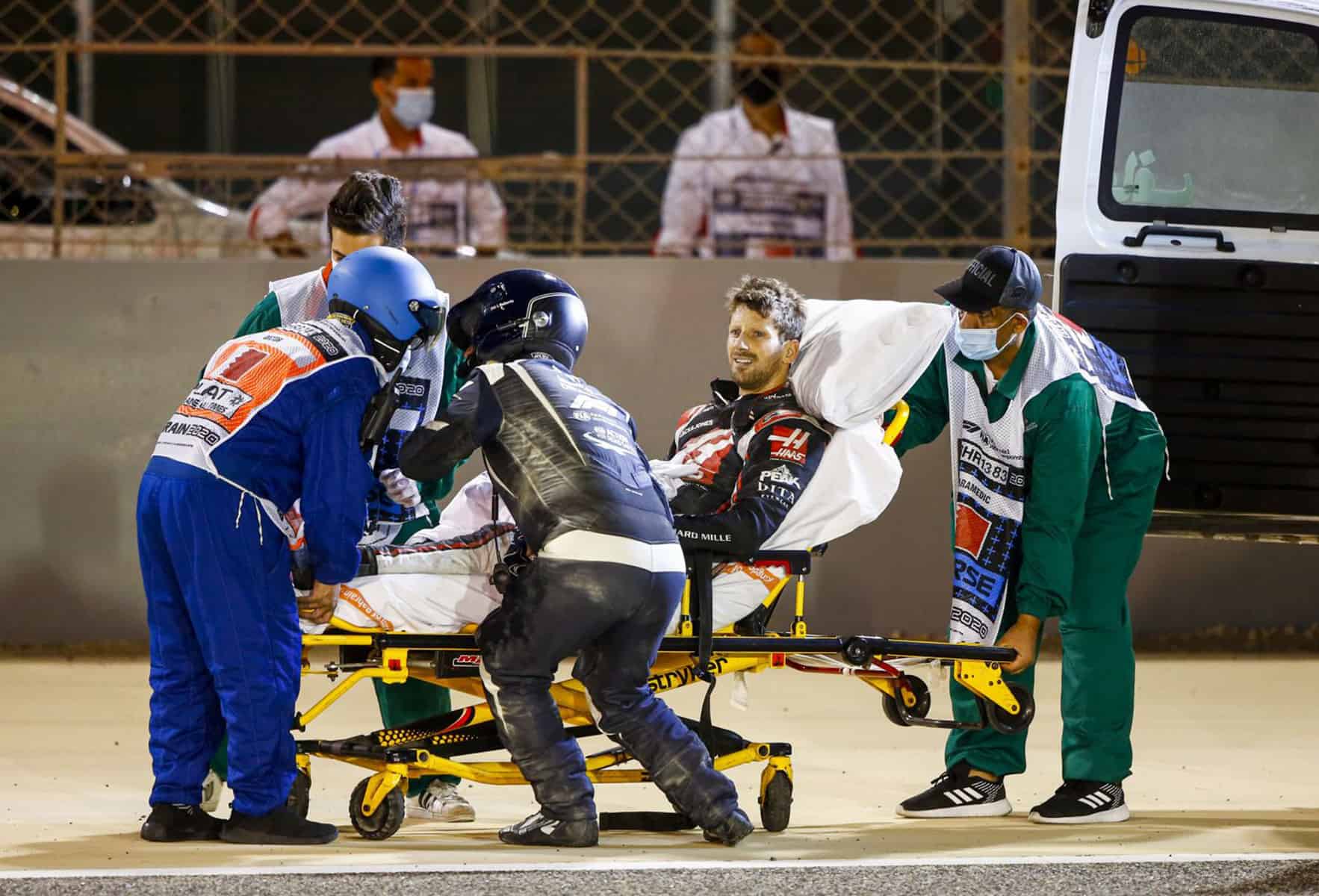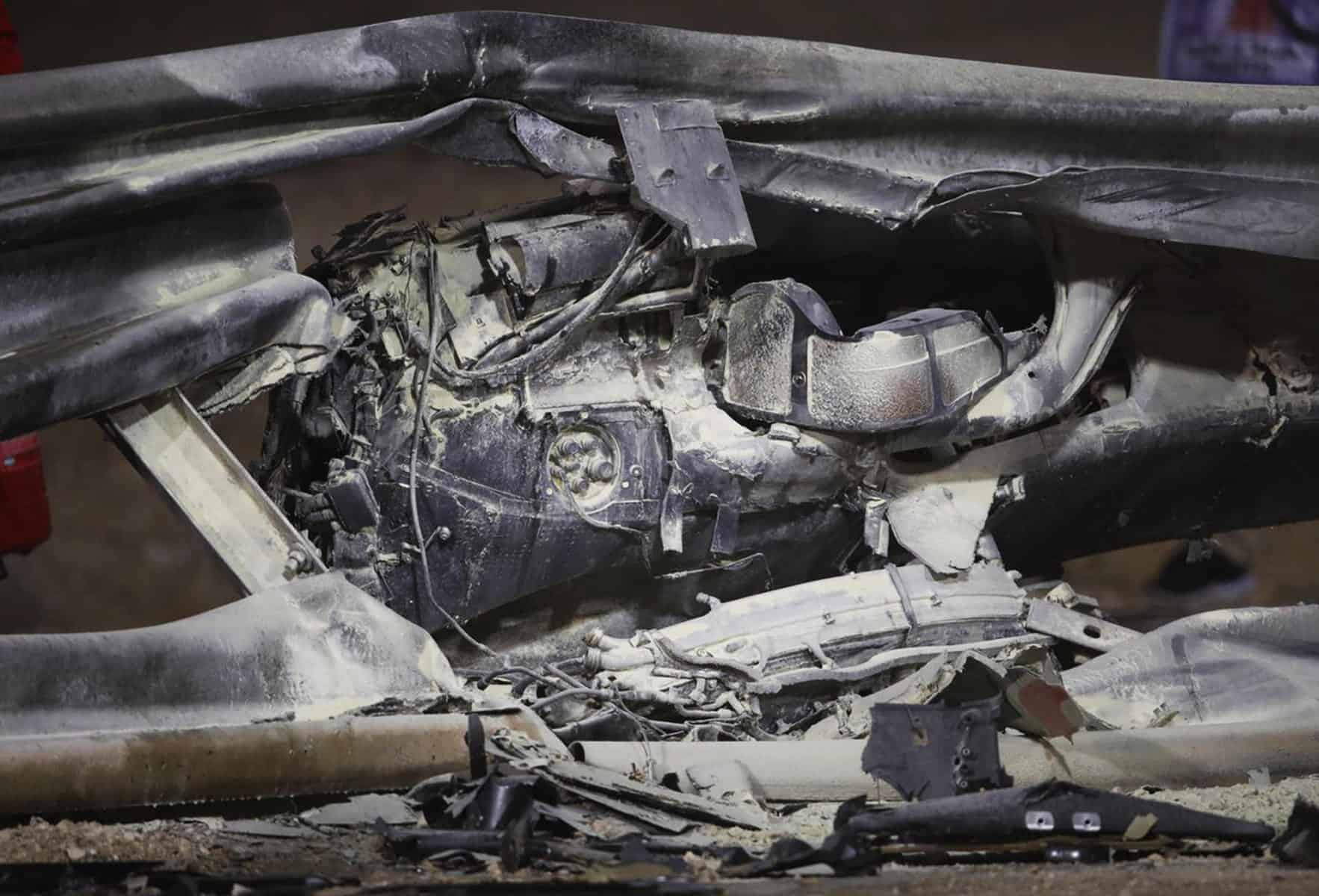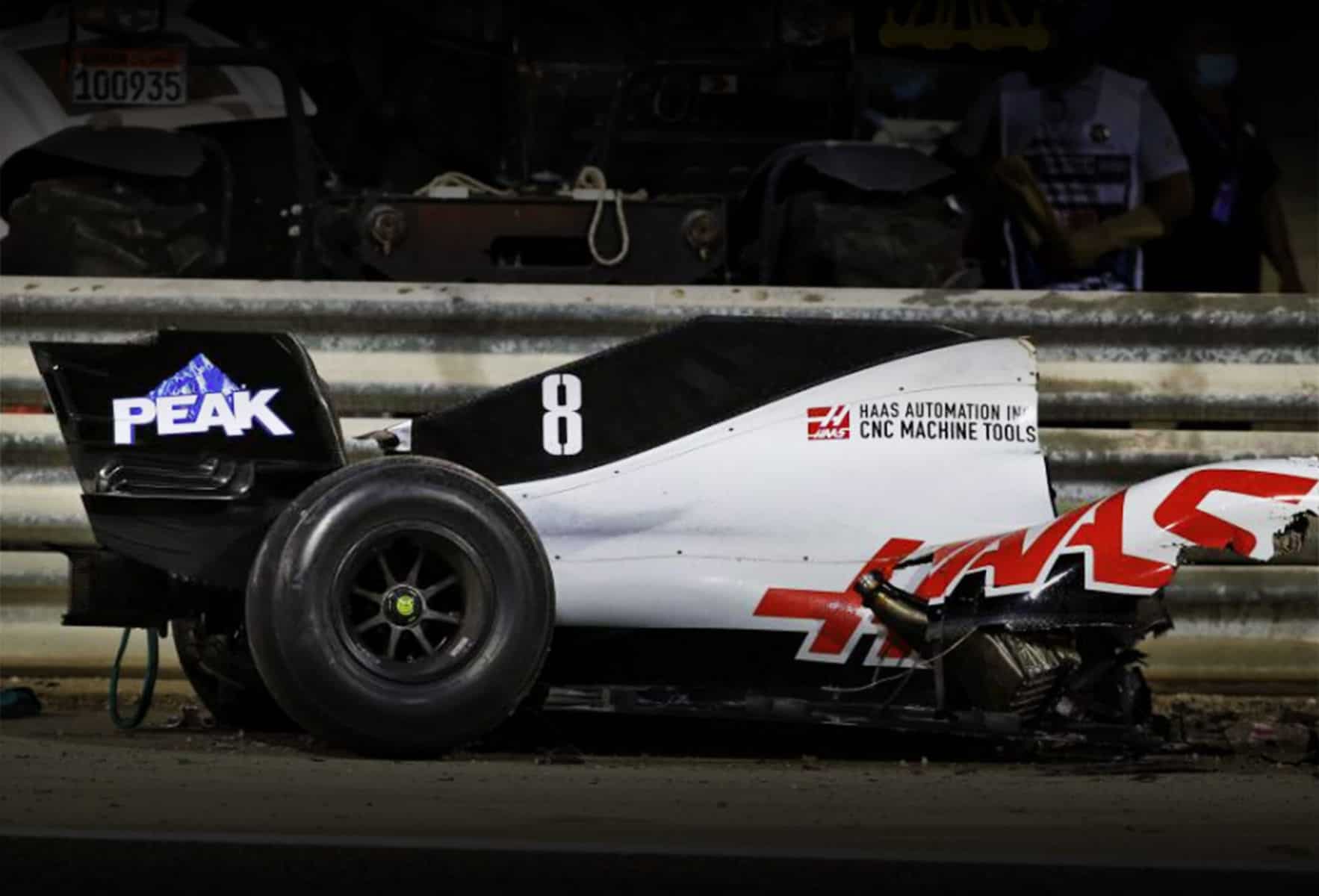Miracle at Bahrain
How Romain Grosjean survived
BY: PETER STEVENS
Peter Stevens was consultant designer for interior, exterior, upper-surface aerodynamics, and homologation on the 1999 Le Mans-winning BMW LM99 sports prototype. Peter worked with Prodrive as a consultant on presentation, design, and aerodynamics. He was responsible for aerodynamics and exterior design for the rally series-winning Subaru Impreza WRCs. He worked as a consultant for Toyota on their GT1 Le Mans project where he was responsible for the cockpit ergonomics and road car design and homologation. He also worked on the Panoz World Sportscar Championship and the McLaren F1 cars run by the David Price Racing championship-winning GT1 team. Peter project managed the record-breaking MG ZT-T estate car’s 226.509 mph run at Bonneville in 2003.
For anyone who has been in motor sport, whether as a driver, designer, engineer, or team member, the crash that so nearly took the life of French Formula 1 driver Romain Grosjean was stunning and then terrifying to witness. That he survived the destruction of his car and its immediate eruption into flames is an indicator of how standards and regulations introduced over the last twenty years have improved race drivers’ security.
Fire has always been the most alarming aspect of any automobile accident. Yes, the forces that the human body is subjected to in a crash can be injurious or even fatal, but there is something deep-seated and primitive about our fear of being trapped in a fire. That is truly frightening.
It was not so long ago that fatalities at all levels of motor sport were too commonplace to be acceptable to any of us now, but back then it was considered “part of the game.” Driving very fast in a slim projectile with 20 gallons of highly volatile fuel around you, sometimes a fuel that you could not even see was burning, was seen as “an acceptable risk.” It is probably live television broadcasting of motor races, with images of the ghastliness of major racing accidents, that prompted the various regulating bodies to take driver safety seriously.
To analyze the American Haas team driver Grosjean’s accident, we are faced with a startlingly rapid set of evolving dynamic issues. The accident happened midway through the first lap of the Bahrain Grand Prix at the Sakhir Circuit. All the cars would have carried a full fuel load for the entire race, usually 105 kg, which equates to around 100 liters (something like 25 U.S. gallons – this all sounds a bit vague but the rules specify weight to stop “super-cooling” the fuel as a way of getting more into the tank!). There was the usual jostling for track position in the first two corners and into the following turn three kink. In the mid-field, Kimi Räikkönen was elbowed off the track to the left whilst there were quite a few drivers almost tripping over each other ahead of Grosjean. He had started from a lowly nineteenth place in a grid of twenty cars; usually the farther back down the field you are at the start the more drama there is. I suspect that not knowing where Räikkönen’s spin was going resulted in his returning onto the left of the track, and seeing potential chaos ahead, Grosjean jinked to the right. Alpha Tauri driver Daniil Kvyat was almost certainly in the Haas driver’s blind spot on his right. Grosjean’s right rear tire tagged the left front of Kvyat and the car speared off to the right, hitting the three-layer Armco barrier at an angle at what is believed to be more than 130 mph. The car appeared to almost immediately explode into a ball of fire, but analysis of the TV footage and later photographs indicates that the nose of the car passed between the two lower layers of the barrier. The entire driver’s safety cell then opened up the gap in the guard rails until even the Halo protective structure caused the rails to separate further. The G-forces resulting from this impact with the guard rails are quoted as being more than 50G. This sudden violent stop by the front of the car tore the heavier rear of the car away from the safety cell structure; a 400 kg element of the car would have to dissipate its energy somehow. Having pulled the car round through more than 150 degrees, this weight broke the engine mounting bolts, ripped off the rear of the fuel cell enclosure, and seemingly split the energy recovery system battery in two. One half of the battery appeared to be still attached to the driver’s safety cell, the other half to the power train in the rear of the car. The front half of the car, containing both the fuel cell and the smaller fuel collector tank, instantly erupted in flame. By great good fortune, Grosjean remained conscious despite the very high impact loading and was able to assess his situation, whether instinctively or rationally we don’t know. He unfastened his five-point safety harness and climbed through the Halo protective structure. Still engulfed in flames he then climbed over the twisted barrier and jumped into the arms of F1’s medical delegate Doctor Ian Roberts. Roberts and medical car driver Alan Van de Merwe (both wearing fire suits) always follow the cars round the first lap and so were just a few seconds behind the field when the crash occurred and were thus almost the first to arrive on the scene. Great praise must be given to the track worker who immediately rushed across the track with a hand-held fire extinguisher to fight the flames, Roberts helpfully directing the man where he should point the extinguisher before guiding Grosjean, who remarkably was able to walk, to the medical car. And here the story takes on an even more remarkable turn. Grosjean suffered only minor burns to his hands, and when he later sent a video tweet from his hospital bed he was calm, smiling, and positive.
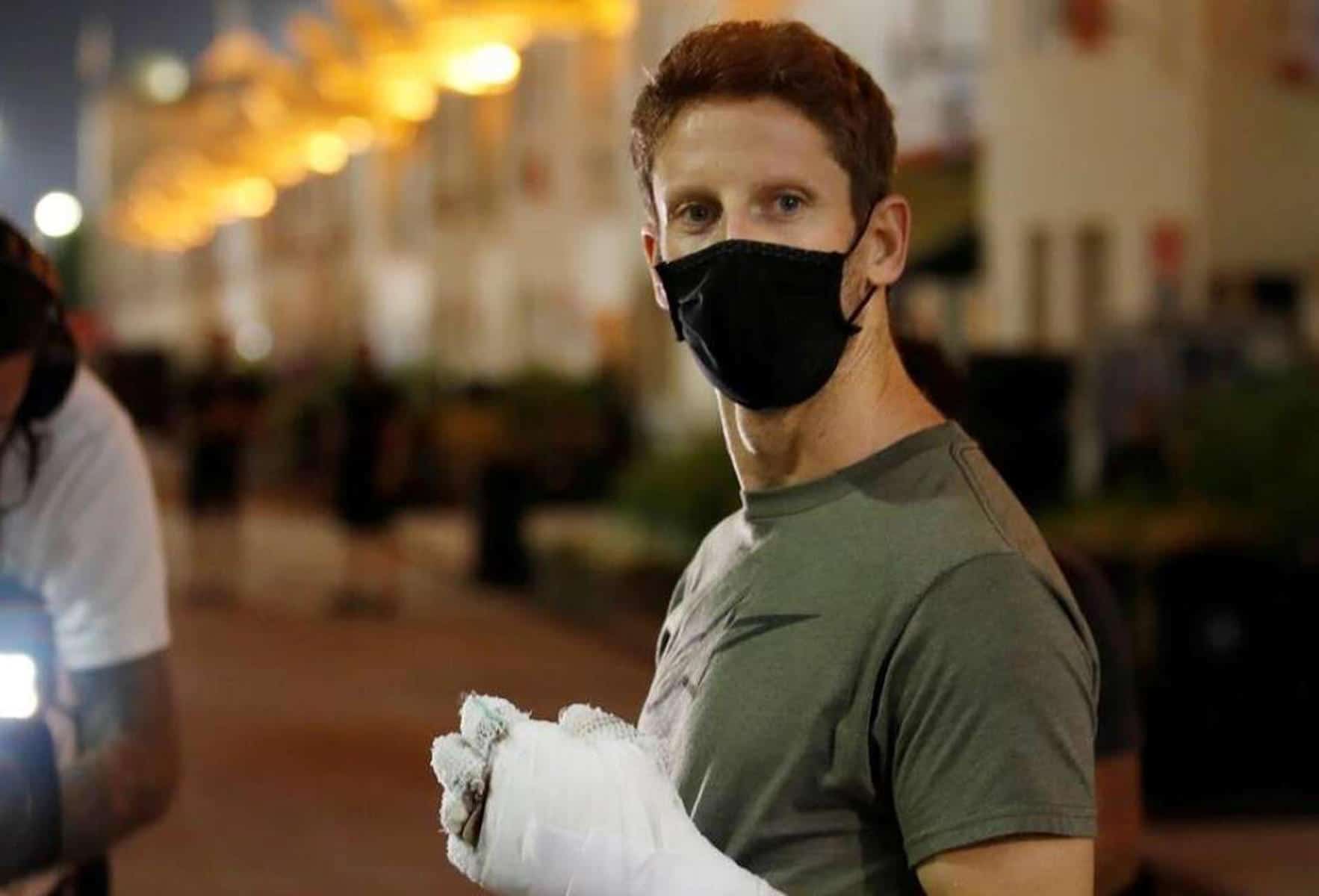
So what caused this potentially fatal accident to have such an apparently positive outcome?
The FIA, governing body of world-wide motor sport, has introduced a number of tough regulations covering car construction, circuit design, driver’s helmets, and race suits. These can be summarized as:
The HANS device, or Head and Neck Support, is the strapped-on carbon structure that is attached to the rear of the drivers’ crash helmet. It prevents strong whiplash injuries in a crash. It has been a mandatory safety feature in F1 since 2003. This undoubtedly prevented Grosjean’s head from a violent impact with the Halo structure, which resulted in him remaining conscious.
The Halo is a two-part, U-shaped tubular bar bolted either side to the carbon-fiber, monocoque chassis behind the driver, it is supported at its front by an angled tube which is also bolted to the chassis in front of the driver. It is made from titanium and when introduced in 2016 weighed 7 kilograms (15 lbs), the following year the tube thickness, and therefore the weight, rose to 9 kilograms (20 lbs). This innovation aimed to reduce the risk of serious head injuries, or even decapitation, during a crash. At the time of its introduction many drivers criticized the Halo, saying it would impair their view ahead. Fans hated how it looked and complained that they could see even less of the drivers, and many engineers disliked the fact that it put a large mass high up in the car when so much of their effort went into reducing weight and lowering the center of gravity. Without a single doubt this one component saved Grosjean’s life. It is remarkable to see that the Halo remained structurally intact despite the huge loads applied to it.
The Safety Cell is the part of the carbon-fiber, monocoque chassis in which the driver sits. First introduced in 1981, there are a series of FIA dynamic crash tests that this element of the car has to pass before it is allowed to race. Side impacts, frontal impacts, impacts from beneath the car and from the rear all have to meet regulations that require a resistance to structural failure. This is one area where engineers do not ever look for a cunning test-compliance strategy (unlike some road car manufacturers who can be a little cavalier in non-safety-critical areas). They all take driver safety very seriously.
The fuel cell is made of Kevlar and rubber and is ballistically tested, it is filled with open cell foam to limit extreme movement of the fuel. But in Grosjean’s accident, the impact appears to have been extreme enough to have damaged it or torn out some of the connections, leading to the fire. In theory all connections are aircraft style, dry-break connectors that cannot leak fuel when separated.
In the case of the Haas car, although the rear of the car was torn off, the safety cell remained intact and unobstructed, giving Grosjean the chance to extricate himself from the remains of the car.
Fireproof Clothing: it would appear from footage of the accident, Grosjean freed himself from the burning car approximately eighteen seconds after impact. According to ex-F1 driver and commentator Karun Chandhok, the FIA has only this year upgraded the fireproof overalls worn by the drivers, which increased their fire-resistant time from ten to twenty seconds.
However, the drivers’ gloves are still of the previous, ten-second-flameproof design, which may explain why Grosjean’s only injuries were second-degree burns to the backs of his hands.
Back in the 1950s, drivers looked cool in polo shirts and slacks, but by the 1960s things improved. In 1963, the FIA brought in its first rules regarding fire suits. The Nomex Heat Shield Firesuit arrived in motor sport after NASCAR’s Bill Simpson was introduced to the material by NASA astronaut Pete Conrad. By 1979 drivers were wearing thick, bulky, five-layer suits made to NASA specifications.
In 1994 the FIA mandated that drivers and pit crews should wear identical safety suits. The old five-layer material was replaced by lightweight and breathable layers of a new Nomex fabric that goes through a rigorous process of washing and drying whilst being tested at 600 to 800 degrees Celsius. Everything, from zips, gloves and socks, to the thread stitching everything together must be able to withstand the same heat. However drivers’ gloves are still only required to pass the ten-second requirement.
Medical and Marshal Response Time. Van de Merwe, driver of the Medical Car, was on the scene within just ten seconds of the crash. He reported to formula1.com: “It was a big surprise for us as the medical team, we’ve never seen that much fire in twelve years. Romain started to get out of the car himself, which was pretty amazing after an accident like that. It was a relief to see he was OK.”
Doctor Ian Roberts told Sky Sports: “There was just a massive flame and as we arrived, it was a very odd scene, we’d got the rear half the car pointing in the wrong direction and then just across the barrier, a mass of heat.
“We needed some way of getting to him, and we had the marshal there with an extinguisher, and the extinguisher was just enough to get the flame away. Romain then got high enough for me to reach over and pull him over the barrier.
“Obviously he was very shaky. His visor was completely opaque and in fact, melted. I had to get his helmet off just to check that everything else was OK.”
The FIA, as the regulatory organization for all global motor sport’s very thorough investigation of the performance of all the relevant systems, will highlight any areas for improvement. “The fire was worrying, the split of the barrier was worrying. Undoubtedly we’ve got to do a very deep analysis of all the events that occurred because there are a number of things that shouldn’t have happened,” Formula 1’s Ross Brawn told Reuters; “The FIA and F1 are to analyze what happened when Grosjean’s car pierced the barriers, split in half, and caught fire.”
FIA Race Director Michael Masi, speaking to Sky Sports F1, said: “We will look at it all and undertake a full investigation of the whole incident, and see what we can learn. Be it car safety, be it driver equipment, be it safety features around the circuit. The survival cell did exactly what it was there to do. It kept the driver safe. But we’ll review the incident itself and see if there’s anything that we can learn in the short term. But, certainly, from the barrier integrity and so forth, there’s no knee-jerking to be done.”
“It was quite a high G [force] load as well so we’ve got to look at how everything failed because everything is designed to fail in a progression, but in a crash that catastrophic obviously things failed in an unpredicted way. The car came apart, we had a fuel fire which is something we haven’t had for a very long time – the fuel cells are incredibly strong,” added former F1 race car designer Ross Brawn.
The reaction of the drivers: Since the race was red flagged at the end of the second lap, all the drivers were required to bring their cars back to the pit lane. On the return lap into the pit area the whole field had driven slowly past the scene of the crash so there was an air of shock and extreme concern for the survival of the driver. It was not until the safe return of Grosjean to the medical center that the live TV feed to the team’s information screens began to show video of the accident. For reasons that are still not clear, the TV feed continued to show clips of the crash from a number of camera positions during the roughly fifty minutes that it took to remove the damaged crash barrier and replace it with a line of temporary concrete blocks. Daniel Ricciardo, lead driver for the Renault team, was very vocal in his condemnation of this relentless re-playing of the the crash, as were other drivers.
What is all the more remarkable to us enthusiasts is the way that the drivers returned to their cars for a re-start of the race and then set out to race hard for the next fifty-four laps. It is said that the concentration required of the drivers at the highest levels of motor racing involves the ability to focus on the job in hand whilst putting all other thoughts aside. The fact that Grosjean’s teammate Kevin Magnussen was able to climb back into his identical Haas car shows the absolute faith the drivers have in the regulations and their engineering teams.
Whilst no form of motor sport can ever be truly safe, the positive outcome from this series of events is that it will become safer, and Grosjean will remain with us.
